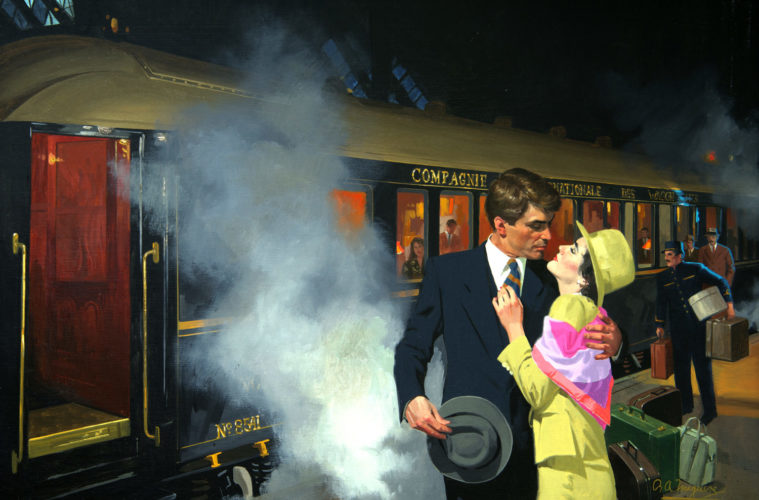My mother was a fashionista decades before the term was first used. She trolled the aisles of Lord & Taylor department store in New Jersey, looking at the latest styles. She read fashion magazines and newspaper columnists (especially Eugenia Sheppard) who personalized fashion by writing about the people who made the clothes and those who wore them. As fashion and art were important aspects of my mother’s raison d’etre, she would have loved this exhibition as it extols the glamor, attention to detail and aesthetic aspects of 20th century couture.
Indeed, Dressed to Thrill, on exhibit at the Hilbert Museum through November 12, displays stunning depictions of fashionable women (and a few men), with many of the paintings and illustrations created for fiction and popular magazines, including Saturday Evening Post, Redbook and McCall’s.
One dramatic painting, Beautiful Woman in Large Hat, for a Cosmopolitan magazine cover, features a larger-than-life portrait of a 1940s glamor girl, replete with exotic make-up, deep red lipstick, arched eyebrows and a large red and white hat framing her face. Artist Bradshaw Crandell also created portraits of famous film stars including Bette Davis, Judy Garland, Veronica Lake, Carol Lombard and Lana Turner.

Bradshaw Crandall, Beautiful Woman in Large Hat (1940), pastel on paper. (Courtesy of the Hilbert Collection)
The elegant painting, Linda Darnell as Lucretia Borgia by Henry Clive, from his “Pin-Up Girls of History” covers series for the American Weekly, hearkens back in its painting style to detailed figurative works of earlier centuries. It also mirrors in style and coloration The Blue Boy by Gainsborough, owned by the Huntington Library in San Marino. The Clive painting transforms Darnell into the notorious Lucretia Borgia (1480-1519), the illegitimate and salacious daughter of Pope Alexander VI. It is an exquisite portrait of a noblewoman dressed in a deep blue velvet Renaissance-style gown and headdress, adorned with pearls. Other actresses posing as notorious historical women for Clive included Claudette Colbert, Marion Davies, Rita Hayworth, Hedy Lamar, Dorothy Lamour and Maureen O’Hara.

Henry Clive, Linda Darnell as Lucretia Borgia (1946), oil on panel. (Courtesy of the Hilbert Collection)
Just Married by Gordon Johnson, also for an American Weekly cover, contrasts Clive’s painting in several ways. The cartoonish Eisenhower era (1956) illustration depicts a just married, fashionably dressed couple, standing alongside a baby blue convertible, engaged in a fierce argument. Curator of the exhibition and Hilbert Museum Director Mary Platt explains, “Hubby seems pretty sure of himself – and he has the map. But his new wife seems equally certain she knows where they should have turned: somewhere back there. We can only hope they work it all out and get to their destination – and that it has a pool, and umbrella drinks!”

Gordon Johnson, Just Married (1956), gouache. (Courtesy of the Hilbert Collection)
The contrasting Scarecrow calendar illustration by Earl Moran is a pin-up style portrait of a curvaceous woman humorously posing as a scarecrow, wearing Halloween colors. Another pin-up is Fritz Willis’s Ice Follies of 1952, a cover illustration for an ice-skating program. This classic painting of a long-legged woman in a scant, fur-adorned skating costume recalls a time when blue-eyed blondes were among the models and prototypes for fashion-conscious girls.
The newest painting in this show is the 1982 Love with a Perfect Stranger by Robert Maguire, created for a romance novel cover. The film noir style work in vibrant colors illustrates a handsome, well-dressed couple kissing goodbye in front of a train, while smoke alongside them coming from the engine takes the form of an apparition. Platt explains, “He [Maguire] was known for his mastery of female characters, especially his femmes fatales, who maintain an air of glamorous mystery but still seem realistic.”

Pruett Carter, Ruth’s Cheeks Flushed; Her Eyes Became Starry (1934), oil on canvas. (Courtesy of the Hilbert Collection)
The most detailed and fanciful painting in the exhibition is Ruth’s Cheeks Flushed; Her Eyes Became Starry (1934) by Pruett Carter. The work is composed of beautiful young women dressed in ball gowns, being wooed by an assortment of male characters, presumably from the movies. They include a sheik, a pirate, and two aristocratic gentlemen from the late 18th century. This cover illustration created for Ladies Home Journal during the Depression must have attracted legions of women to purchase and read through the magazine, and to try to mimic the gorgeous models on the cover in their style of dress and makeup. Carter is quoted in the exhibition didactics: “The illustrator may be likened to the director of a motion picture. He must live the part of each actor. He must do the scenery, design the costumes, and handle the lighting effects.”

Joseph Christian (J.C.) Leyendecker, Fitted for a Suit (1916), oil on canvas. (Courtesy of the Hilbert Collection)
A fashionable boy also has a place in this exhibition, with Fitted for a Suit by Joseph Christian Leyendecker, created for a 1916 Saturday Evening Post cover. The painting by the German-born artist – who inspired and influenced Norman Rockwell – depicts a startled young man being fitted by an old, curmudgeonly tailor. Leyendecker studied art at the Art Institute of Chicago and the Académie Julian in Paris, and created 322 covers for the Post, including New Year’s Baby, the pudgy, red-garbed Santa Claus, flowers for Mother’s Day, and firecrackers on the 4th of July.
The exhibition, featuring several other paintings and illustrations of well-dressed and coifed women, brings viewers to a time when glamor and elegant couture helped define a woman’s (and a man’s) social standing – and when clever marketing in magazines helped propel our country’s high-fashion industry to major status on the world stage.
“Dressed to Thrill” is on view through November 12. Hilbert Museum of California Art, 167 N. Atchison Street, Orange, CA. Tue. – Sat., 11 am – 5 pm. 714-516-5880. Free. hilbertmuseum.com

Earl Moran, Scarecrow, (Undated, probably 1940s), pastel on board. (Courtesy of the Hilbert Collection)



